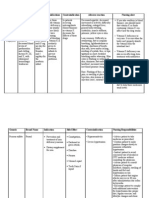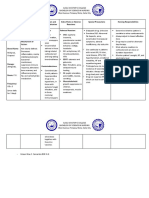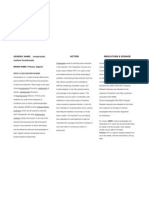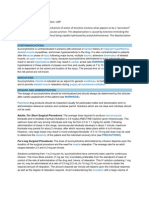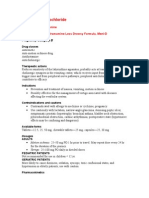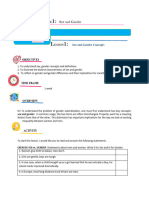0 ratings0% found this document useful (0 votes)
185 viewsDrug Study
Drug Study
Uploaded by
Jay VillasotoThis document provides information on the drug pantroprazole, including its mechanism of action, indications, contraindications, and nursing responsibilities. Pantroprazole inhibits gastric acid secretion by blocking the proton pump. It is indicated for duodenal and gastric ulcers, gastroesophageal reflux disease, and eradication of H. pylori infections. Nurses should observe proper medication administration, monitor for potential adverse effects or drug interactions, and educate patients about reporting symptoms like abdominal pain or bleeding.
Copyright:
© All Rights Reserved
Available Formats
Download as DOCX, PDF, TXT or read online from Scribd
Drug Study
Drug Study
Uploaded by
Jay Villasoto0 ratings0% found this document useful (0 votes)
185 views11 pagesThis document provides information on the drug pantroprazole, including its mechanism of action, indications, contraindications, and nursing responsibilities. Pantroprazole inhibits gastric acid secretion by blocking the proton pump. It is indicated for duodenal and gastric ulcers, gastroesophageal reflux disease, and eradication of H. pylori infections. Nurses should observe proper medication administration, monitor for potential adverse effects or drug interactions, and educate patients about reporting symptoms like abdominal pain or bleeding.
Original Description:
Original Title
DRUG STUDY
Copyright
© © All Rights Reserved
Available Formats
DOCX, PDF, TXT or read online from Scribd
Share this document
Did you find this document useful?
Is this content inappropriate?
This document provides information on the drug pantroprazole, including its mechanism of action, indications, contraindications, and nursing responsibilities. Pantroprazole inhibits gastric acid secretion by blocking the proton pump. It is indicated for duodenal and gastric ulcers, gastroesophageal reflux disease, and eradication of H. pylori infections. Nurses should observe proper medication administration, monitor for potential adverse effects or drug interactions, and educate patients about reporting symptoms like abdominal pain or bleeding.
Copyright:
© All Rights Reserved
Available Formats
Download as DOCX, PDF, TXT or read online from Scribd
Download as docx, pdf, or txt
0 ratings0% found this document useful (0 votes)
185 views11 pagesDrug Study
Drug Study
Uploaded by
Jay VillasotoThis document provides information on the drug pantroprazole, including its mechanism of action, indications, contraindications, and nursing responsibilities. Pantroprazole inhibits gastric acid secretion by blocking the proton pump. It is indicated for duodenal and gastric ulcers, gastroesophageal reflux disease, and eradication of H. pylori infections. Nurses should observe proper medication administration, monitor for potential adverse effects or drug interactions, and educate patients about reporting symptoms like abdominal pain or bleeding.
Copyright:
© All Rights Reserved
Available Formats
Download as DOCX, PDF, TXT or read online from Scribd
Download as docx, pdf, or txt
You are on page 1of 11
Drug Action Indication/Contraindication Nursing Responsibilities
Generic Name: Mechanism of action: Indication: Observe 12 rights of medication
norgestimate and Oral Contraception Oral Contraceptive
ethinyl estradiol COCs lower the risk of ORTHO-CYCLEN and ORTHO Monitor for the development of breast or
Brand Name: becoming pregnant TRI-CYCLEN Tablets are other estrogen-dependent tumors
Ortho Tri-Cyclen primarily by suppressing indicated for use by females
Classification: ovulation. Other possible of reproductive potential to Monitor for thrombophlebitis or other
mechanisms may
Estrogens/Progestins prevent pregnancy. thromboembolic disease.
include cervical mucus
; Contraceptives, changes that inhibit
Dosage: sperm penetration and
Acne Encourage client not to smoke.
1 tab daily ORTHO TRI-CYCLEN is
endometrial changes
Route: that reduce the indicated for the treatment Monitor client’s knowledge level of proper
Oral likelihood of of moderate acne vulgaris in administration
implantation. females at least 15 years of
age, who have no known
Acne contraindications to oral
Acne is a skin condition contraceptive therapy and
with a multifactorial have achieved menarche.
etiology, including ORTHO TRI-CYCLEN should
androgen stimulation of be used for the treatment of
sebum production. While acne only if the patient
the combination of desires an oral contraceptive
ethinyl estradiol and for birth control.
norgestimate increases
sex hormone-binding Contraindication
globulin (SHBG) and
Smoke, if over age
decreases free
testosterone, the 35
relationship between Have deep vein
these changes and a thrombosis or
decrease in the severity pulmonary
of facial acne in embolism
otherwise healthy Have inherited or
women with this skin acquired
condition has not been hypercoagulopathies
established. Have
cerebrovascular
disease
Have coronary artery
disease
Have uncontrolled
hypertension
Side effects
Irregular uterine
bleeding
Nausea
Breast tenderness
Headache
Drug Action Indication/Contraindication Nursing Responsibilities
Generic Name: Mechanism of action: Indication: Observe 12 rights of medication
Ibuprofen Relief of signs and
Brand Name: Antiinflammatory, symptoms of rheumatoid Administer drug with food or after meals if
Advil analgesic, and arthritis and osteoarthritis GI upset occurs.
Classification: antipyretic · Relief of mild to moderate
Nonsteroidalanti- activities pain Discontinue drug if eye changes, symptoms
inflammatorydrug largely related · Treatment of primary of liver dysfunction, renal impairment
(NSAID) to inhibition of dysmenorrhea occur.
Analgesic prostaglandin · Fever reduction
synthesis; exact Teach patient to watch for and report to
Dosage: mechanisms of prescriber immediately signs and
Pain/Fever/Dysmenorrhe action are not Contraindication symptoms of GI bleeding, including blood
a known Contraindicated with allergy invomit, urine, or stool
OTC: 200-400 mg PO to ibuprofen, salicylates, or or coffee ground vomit.
q4-6hr; not to exceed other NSAIDs (more
1200 mg unless directed common in patients with Tell patient to take with meals or milk to
by physician rhinitis, asthma, chronic reduce adverse GI reactions.
urticaria, nasal polyps); CV
dysfunction, hypertension;
Prescription: 400-800 mg
peptic ulceration, GI
PO q6hr; not to exceed
bleeding; pregnancy;
3200 mg/day
lactation.
Inflammatory Disease
Side effects:
400-800 mg PO q6-8hr;
Headache
not to exceed 3200
Dizziness
mg/day
Somnolence
Insomnia
Rheumatoid Arthritis
Fatigue
300 mg, 400 mg, 600 mg,
Tiredness
or 800 mg PO q6-8hr; not
Dizziness
to exceed 3200 mg/day
Tinnitus
ophthalmologic
effects
Route: Rash
Oral Pruritus
Sweating
dry mucous
membranes
stomatitis
Nausea
Drug Action Indication/Contraindication Nursing Responsibilities
Generic Name: Mechanism of action: Indication:
Pantroprazole Duodenal and gastric ulcer, moderate Observe 12 rights of
Brand Name: Inhibits both basal and stimulated and severe reflux esophagitis. medication
Protonix gastric acid secretion by suppressing Eradication of H. pylori inpatient with
Classification: the final step in acids production, peptic ulcers, pathological hyper Monitor for possible
proton pump inhibitors through the inhabitation of the secretory conditions. Symptomatic drug induced
Dosage: proton pump by binding to and improvement and healing of mild reflux adverse reaction.
Erosive Esophagitis inhibiting hydrogenpotassium esophagitis. Prevention of Assess GI symptoms:
Associated With GERD adenosine triphosphatase, the gastroduodenal ulcers induced by NSAID epigastric/abdominal
Treatment: 40 mg PO enzyme system located at the in patients at risk with a need for pain, bleeding and
qDay for 8-16 weeks secretory surface of the gastric continuous NSAID treatment. anorexia.
parietal cell. Inspect the skin for
Contraindication lesions, rash,
Short-term Treatment of
Known hypersensitivity to any of the pruritus, and dryness
GERD
constituents of Pantoloc or of the to identify possible
Oral therapy
combination partners. Mild adverse effects.
inappropriate or not
gastrointestinal complaints eg, nervous Assess for possible
possible: 40 mg IV
dyspepsia. Pantoloc must not be used in contraindications
infusion over 15 minutes
combination treatment for eradication and cautions: history
qDay for 7-10 days;
of H. pylori in patients with moderate to of allergy to a proton
switch to PO once patient pump inhibitor to
severe hepatic or renal dysfunction
able to swallow reduce the risk of
Side effects:
Headache hypersensitivity
Zollinger-Ellison
Dizziness reaction and current
Syndrome
Somnolence status of pregnancy
40 mg PO qDay; up to
Insomnia
240 mg/day administered
Fatigue
in some patients
Tiredness
80 mg IV infusion q8-
Thrombophlebitis
12hr up to 7 days; switch
diarrhea
to PO once patient able to
swallow
Peptic Ulcer Disease
(Off-label)
Duodenal ulcer: 40 mg
PO qDay for 2 weeks
Gastric ulcer: 40 mg PO
qDay for 4 weeks
Route:
Oral
Drug Action Indication/Contraindication Nursing Responsibilities
Generic Name: Mechanism of action: Indication:
Omeprazole Prochlorperazine is used to treat Observe 12 rights of
Brand Name: An antisecretory compound that nervous, emotional, and mental medication
Prisolec is a gastric acid pump inhibitor. conditions (eg, schizophrenia) and
Classification: Suppresses gastric acid secretion non-psychotic anxiety. It is also used Positioned
proton pump inhibitors by inhibiting the H+, K+-ATPase to control severe nausea and nauseated patients
Dosage: enzyme system [the acid (proton vomiting. This medicine should not who have received
10 mg, 20 mg, 40 mg H+) pump] in the parietal cells. be used to treat behavioral problems prochlorperazine
capsules; 20 mg powder carefully to prevent
in older adult patients who have
for oral suspension aspiration of
dementia.
vomitus; may have
depressed cough
Route: Contraindication
reflex.
Oral It is important to note that geriatric
patients with dementia have a higher Most older adult and
emaciated patients
risk of death when treated with an
antipsychotic, including and children,
especially those with
prochlorperazine.
History of allergy to
dehydration or acute
illness, appear to be
prochlorperazine or the
phenothiazine drug class particularly
susceptible to
Concomitant use of CNS
depressants (opioids, extrapyramidal
effects. Be alert to
benzodiazepines, and
barbiturates) leading to sedation onset of symptoms:
Early in therapy
Concomitant use of
anticholinergic medications watch for
pseudoparkinson's
(scopolamine, atropine, etc.)
Pre-existing cardiac conduction
and acute dyskinesia.
After 1–2 mo, be
abnormalities
History of seizure/epilepsy
alert to akathisia.
(prochlorperazine lowers seizure Keep in mind that
threshold) the antiemetic effect
Narrow-angle glaucoma
may mask toxicity of
Prostatic hypertrophy
other drugs or make
Past or current history of tardive it difficult to
dyskinesia diagnose conditions
Patients under two years of age with a primary
symptom of nausea,
Side Effects: such as intestinal
Headache obstruction and
dizziness increased
fatigue intracranial pressure.
Lab tests: Periodic
Adverse Reactions: CBC with differential
Anorexia in long-term therapy.
Dyspepsia Be alert to signs of
Constipation high core
Diarrhea temperature: Red,
Ileus dry, hot skin; full
Blood dyscrasia bounding pulse;
Galactorrhea dilated pupils;
Gynecomastia dyspnea; confusion;
temperature over
40.6° C (105° F);
elevated BP.
Exposure to high
environmental
temperature, to
sun's rays, or to a
high fever associated
with serious illness
places this patient at
risk for heat stroke.
Inform physician and
institute measures to
reduce body
temperature rapidly.
Drug Action Indication/Contraindication Nursing Responsibilities
Generic Name: Mechanism of action: Indication:
prochlorperazine Duodenal and gastric ulcer.
Brand Name: As a first-generation Gastroesophageal reflux
Compazine antipsychotic, prochlorperazine mainl
disease including severe
Classification: y blocks D2 dopamine receptors in the
antipsychotics brain. It can also block histaminergic, erosive esophagitis (4 to 8
Dosage: cholinergic, and noradrenergic wk treatment).
Severe Nausea & receptors. Long-term treatment of
Vomiting pathologic hypersecretory
PO: Immediate-release, conditions such as
5-10 mg q6-8hr; Zollinger-Ellison syndrome,
extended-release, 10 mg
multiple endocrine
q12hr or 15 mg every
morning adenomas, and systemic
Suppository: 25 mg mastocytosis.
q12hr In combination with
IM: 5-10 mg q3-4hr; not clarithromycin to treat
to exceed 40 mg/day duodenal ulcers associated
IV: 2.5-10 mg q3-4hr;
with Helicobacter pylori.
not to exceed 10
mg/dose or 40 mg/day Contraindication
Long-term use for
Route:
Oral, IV, IM gastroesophageal reflux
disease (GERD)
duodenal ulcers; proton
pump inhibitors (PPIs),
hypersensitivity; children <2
y; use of OTC formulation
in children <18 y or GI
bleeding; pregnancy
use of Zegerid in metabolic
alkalosis, hypocalcemia,
vomiting, GI bleeding.
Side Effects:
Headache
dizziness
fatigue
abdominal pain
nausea
Adverse Reactions:
Mild Transient Increases In
Liver Function Tests
Hematuria
Proteinuria
Rash
You might also like
- Clinical Teaching Plan - NCM 117 (Student's Copy)Document32 pagesClinical Teaching Plan - NCM 117 (Student's Copy)Jay Villasoto100% (4)
- English For MidwiferyDocument9 pagesEnglish For MidwiferyRetno AW100% (3)
- Front of Me. She Is A Good Cook." For The Past Few Months, Mrs. Jenaro HasDocument5 pagesFront of Me. She Is A Good Cook." For The Past Few Months, Mrs. Jenaro Hasnct thomasNo ratings yet
- Case Study Kay Maam NitzDocument19 pagesCase Study Kay Maam NitzJay Villasoto100% (1)
- Radiation Safety QuizDocument4 pagesRadiation Safety QuizMaja JovanovicNo ratings yet
- STG and Nemlt 2021Document618 pagesSTG and Nemlt 2021Emmanuel Ngimba100% (2)
- Glipizide Glucotrol XL Drug CardDocument1 pageGlipizide Glucotrol XL Drug CardSheri490No ratings yet
- Ertapenem (Invanz)Document1 pageErtapenem (Invanz)Adrianne Bazo100% (1)
- Nurse Patient Analysis Verbal Non-Verbal Verbal Non - Verbal Therapeutic Technique AnalysisDocument6 pagesNurse Patient Analysis Verbal Non-Verbal Verbal Non - Verbal Therapeutic Technique AnalysisJay VillasotoNo ratings yet
- Definition of TermsDocument3 pagesDefinition of TermsJay VillasotoNo ratings yet
- Hydroxy ZineDocument2 pagesHydroxy ZineSharmaine Grace FlorigNo ratings yet
- Drug Name Mechanism of Action Administration Indication Contraindication Adverse Effects Nursing ResponsibilitiesDocument1 pageDrug Name Mechanism of Action Administration Indication Contraindication Adverse Effects Nursing ResponsibilitiesIvan Liquiran AvenadoNo ratings yet
- Amikacin 2Document2 pagesAmikacin 2Sian AsadaNo ratings yet
- KaliumDocument2 pagesKaliumJustine Kaye Iballa HarligaNo ratings yet
- Drug Analysis: Malaise, Fatigue, Dizziness, Tremors, AtaxiaDocument2 pagesDrug Analysis: Malaise, Fatigue, Dizziness, Tremors, AtaxiaFerdinand Sherwin MorataNo ratings yet
- Drug Study (Romel Cruz Hospital)Document35 pagesDrug Study (Romel Cruz Hospital)Djoan SamontañezNo ratings yet
- FragminDocument2 pagesFragminNinoska Garcia-Ortiz100% (1)
- Dolan Drug StudyDocument3 pagesDolan Drug StudyLian Robbie BautistaNo ratings yet
- NCP & Drug Study (Tondo Med)Document5 pagesNCP & Drug Study (Tondo Med)Kevin_Remollo_2431No ratings yet
- Drug Study: Meclizine Is An Antagonist atDocument2 pagesDrug Study: Meclizine Is An Antagonist atJayson Ray AbellarNo ratings yet
- DrugStudy - CamaristaColeenMaeC (BSN III-G) (Prednisone)Document2 pagesDrugStudy - CamaristaColeenMaeC (BSN III-G) (Prednisone)Coleen Mae CamaristaNo ratings yet
- TheophyllineDocument6 pagesTheophyllineapi-3797941100% (1)
- Side Effects:: AtropineDocument7 pagesSide Effects:: AtropinekletadaNo ratings yet
- Dinoprostone GelDocument7 pagesDinoprostone GelSahil AliNo ratings yet
- Dosage: 50 MG Order: PRN q6h Route: IV (Case Scenario Based)Document3 pagesDosage: 50 MG Order: PRN q6h Route: IV (Case Scenario Based)Edward Luis EsguerraNo ratings yet
- Drug Study: (Celecoxib)Document11 pagesDrug Study: (Celecoxib)Princess Brigitte R. PATE�ANo ratings yet
- Dinoprostone and Metronidazole Drug StudyDocument3 pagesDinoprostone and Metronidazole Drug StudyMary Shane MoraldeNo ratings yet
- NizoralDocument4 pagesNizoralianecunar100% (2)
- Drug AnalysisDocument3 pagesDrug AnalysisAnn Aquino100% (1)
- Drug Card TamifluDocument1 pageDrug Card TamifluAdrianne BazoNo ratings yet
- Emergency Drug StudyDocument3 pagesEmergency Drug StudyGrace Santos MirandaNo ratings yet
- Omeprazole - Drug StudyDocument2 pagesOmeprazole - Drug StudyJun Gilbuena100% (1)
- BrivaracetamDocument110 pagesBrivaracetamBendisDacicaNo ratings yet
- Drug Study HepatitisDocument7 pagesDrug Study HepatitisKateLayaogNo ratings yet
- Omeprazole Drug StudyDocument4 pagesOmeprazole Drug StudyFeliza Therese A. DeloriaNo ratings yet
- Drugstudy OrsdDocument10 pagesDrugstudy OrsdRafmar A. SalundaguitNo ratings yet
- Generic Name: Acute Aspirin ToxicityDocument1 pageGeneric Name: Acute Aspirin ToxicityShermayne Mallapre HernandezNo ratings yet
- Drug Study Emergency DrugsDocument6 pagesDrug Study Emergency DrugsJhessa Curie PitaganNo ratings yet
- Drug Study Amlodipine & HydrocortisoneDocument4 pagesDrug Study Amlodipine & HydrocortisoneJohn Kristoffer JisonNo ratings yet
- Drug StudyDocument4 pagesDrug StudyAbigail LonoganNo ratings yet
- LOSARTAN (ARBs) Drug Study (GERIATRICS)Document5 pagesLOSARTAN (ARBs) Drug Study (GERIATRICS)CHRISTIE MONTANONo ratings yet
- Drug Study Clindamycin, Ipatropium BromideDocument8 pagesDrug Study Clindamycin, Ipatropium Bromidepaupaulala100% (2)
- Drug StudyDocument2 pagesDrug Studymegreen GamingNo ratings yet
- Drug Study, NCPDocument8 pagesDrug Study, NCPtintinNo ratings yet
- GravolDocument5 pagesGravoldrugcardrefNo ratings yet
- Drug Study AMIODARONE & PROPOFOLDocument3 pagesDrug Study AMIODARONE & PROPOFOLNIKKI CARYL ZAFRANo ratings yet
- OxytocinDocument1 pageOxytocinJoi Danielle Tabares IsturisNo ratings yet
- AmisulprideDocument4 pagesAmisulprideKhristle DavidNo ratings yet
- Drug Study of FluoxetineDocument2 pagesDrug Study of FluoxetineLance De GuzmanNo ratings yet
- 7 Midazozalam Drug StudyDocument3 pages7 Midazozalam Drug Studyshadow gonzalezNo ratings yet
- Name of Drug Dosage, Route, Frequency and Timing Mechanism of Action Indication Adverse Reactions Special Precautions Nursing ResponsibilitiesDocument2 pagesName of Drug Dosage, Route, Frequency and Timing Mechanism of Action Indication Adverse Reactions Special Precautions Nursing ResponsibilitiesIvan Matthew SuperioNo ratings yet
- Drug LovenoxDocument2 pagesDrug LovenoxSrkocherNo ratings yet
- © The Mechanism of Action of Anectine Involves What Appears To Be A "Persistent"Document6 pages© The Mechanism of Action of Anectine Involves What Appears To Be A "Persistent"kaye marie100% (1)
- Insulin NPHDocument1 pageInsulin NPHChristopher LeeNo ratings yet
- Vitamin K (Phytomenadione) 2016: Indication Action Drug Type Trade Name Presentation Dosage / IntervalDocument3 pagesVitamin K (Phytomenadione) 2016: Indication Action Drug Type Trade Name Presentation Dosage / IntervalDeni Yuda Adi SaputraNo ratings yet
- IV Morphine SulfateDocument1 pageIV Morphine SulfateMelissa HarndenNo ratings yet
- Spinal Anes Drug StudyDocument12 pagesSpinal Anes Drug StudyNicosia Mae FerrerNo ratings yet
- Drug Study: Name of PatientDocument1 pageDrug Study: Name of PatientKaloy KamaoNo ratings yet
- Meclizine Hydro ChlorideDocument3 pagesMeclizine Hydro Chlorideapi-3797941100% (1)
- Drug Study KeterolacDocument2 pagesDrug Study KeterolacKillerBall RegioNo ratings yet
- Metformin in PregnancyDocument31 pagesMetformin in PregnancyPrashant SardaNo ratings yet
- The Ride of Your Life: What I Learned about God, Love, and Adventure by Teaching My Son to Ride a BikeFrom EverandThe Ride of Your Life: What I Learned about God, Love, and Adventure by Teaching My Son to Ride a BikeRating: 4.5 out of 5 stars4.5/5 (2)
- A Simple Guide to Pseudohypoparathyroidism, Diagnosis, Treatment and Related ConditionsFrom EverandA Simple Guide to Pseudohypoparathyroidism, Diagnosis, Treatment and Related ConditionsNo ratings yet
- Generic Name:: Norgestimate and Ethinyl EstradiolDocument5 pagesGeneric Name:: Norgestimate and Ethinyl EstradiolJay VillasotoNo ratings yet
- DRUG STUDY (Diethystilbestrol)Document2 pagesDRUG STUDY (Diethystilbestrol)Avianna CalliopeNo ratings yet
- Drug StudyDocument7 pagesDrug Studyanne009No ratings yet
- Drug StudyDocument2 pagesDrug StudyJan Lianne BernalesNo ratings yet
- St. Anthony College of Roxas CityDocument3 pagesSt. Anthony College of Roxas CityJay VillasotoNo ratings yet
- Rizal WorksheetDocument2 pagesRizal WorksheetJay VillasotoNo ratings yet
- Journal 1Document1 pageJournal 1Jay VillasotoNo ratings yet
- Assessment Nursing Diagnosis Planning Intervention and Core Competency Rationale Nursing Theory Vincentian Core Values EvaluationDocument2 pagesAssessment Nursing Diagnosis Planning Intervention and Core Competency Rationale Nursing Theory Vincentian Core Values EvaluationJay VillasotoNo ratings yet
- St. Anthony College of Roxas City, Inc.: Bachelor of Science in NursingDocument86 pagesSt. Anthony College of Roxas City, Inc.: Bachelor of Science in NursingJay VillasotoNo ratings yet
- Name Generic Class of Drug Patient'S Dose and Route Usual Dose Recommended Target Symptoms Drug Is Intended To Address Top 3-5 Nursing ImplicationsDocument3 pagesName Generic Class of Drug Patient'S Dose and Route Usual Dose Recommended Target Symptoms Drug Is Intended To Address Top 3-5 Nursing ImplicationsJay VillasotoNo ratings yet
- 8 Decontamination Disinfection SterilizationDocument8 pages8 Decontamination Disinfection SterilizationJay VillasotoNo ratings yet
- 5 Surgical InstrumentationDocument34 pages5 Surgical InstrumentationJay VillasotoNo ratings yet
- DoctorDocument4 pagesDoctorJay VillasotoNo ratings yet
- 6 Attire Scrubbing Gowning GlovingDocument21 pages6 Attire Scrubbing Gowning GlovingJay VillasotoNo ratings yet
- QuestionairreDocument5 pagesQuestionairreJay VillasotoNo ratings yet
- DelfinDocument13 pagesDelfinJay VillasotoNo ratings yet
- St. Anthony College of Roxas City, Inc.: Bachelor of Science in NursingDocument12 pagesSt. Anthony College of Roxas City, Inc.: Bachelor of Science in NursingJay VillasotoNo ratings yet
- Manuscript-research-Impact With CorrectionsDocument88 pagesManuscript-research-Impact With CorrectionsJay VillasotoNo ratings yet
- St. Anthony College of Roxas City, IncDocument2 pagesSt. Anthony College of Roxas City, IncJay VillasotoNo ratings yet
- Reproduction (Human & Plant) KODocument6 pagesReproduction (Human & Plant) KODearbhla HubbardNo ratings yet
- Technical Notes Community Health NursingDocument8 pagesTechnical Notes Community Health NursingMary JoyNo ratings yet
- Induction of Lactation in Crossbred CattleDocument12 pagesInduction of Lactation in Crossbred CattleDr. MANOJ SHARMA100% (3)
- Midterm109 QuestionDocument9 pagesMidterm109 Questionv6gv29sdv8No ratings yet
- Abstrak InggrisDocument3 pagesAbstrak InggrisKhikmahNo ratings yet
- Sexually Transmitted Infections: Hemant K. Satpathy, Albert Asante and Mark GoodmanDocument13 pagesSexually Transmitted Infections: Hemant K. Satpathy, Albert Asante and Mark GoodmanDana Abdallah Jalal AlnimriNo ratings yet
- DOC1Document6 pagesDOC1Ryan MijaresNo ratings yet
- Full Download Environment Science Issues Solutions 1st Edition Molles Test BankDocument35 pagesFull Download Environment Science Issues Solutions 1st Edition Molles Test Bankwaymarkbirdlimengh1j100% (31)
- Long-Term Decline in US Abortions ReversesDocument8 pagesLong-Term Decline in US Abortions Reversesguttmacher institute100% (1)
- Applications of Diagnostic Ultrasonography in Small Ruminant Reproductive ManagementDocument3 pagesApplications of Diagnostic Ultrasonography in Small Ruminant Reproductive ManagementAlexander Cañar RomeroNo ratings yet
- Unit II. Unpacking The SelfDocument28 pagesUnit II. Unpacking The SelfKhyne Dela RosaNo ratings yet
- Intensive Care of The Neonatal FoalDocument32 pagesIntensive Care of The Neonatal FoalAristoteles Esteban Cine VelazquezNo ratings yet
- Hemorrhoids in PregnancyDocument3 pagesHemorrhoids in PregnancySalwa Rizky SalsabillaNo ratings yet
- Currens Math For Meds Dosages and Solutions 11th Edition Curren Test BankDocument36 pagesCurrens Math For Meds Dosages and Solutions 11th Edition Curren Test Banksynechia.goblinqrs4v100% (37)
- Psychological Disorders During Puererium Lesson PlanDocument20 pagesPsychological Disorders During Puererium Lesson PlanSANCHAYEETANo ratings yet
- Mnemonics and Acronyms For Nursing SchoolDocument20 pagesMnemonics and Acronyms For Nursing SchoolFaye G.100% (3)
- Review of Related Literature of Gumamela PerfumeDocument4 pagesReview of Related Literature of Gumamela PerfumeafduadazaNo ratings yet
- Anatomy, Lecture 9, Abdominal WallDocument22 pagesAnatomy, Lecture 9, Abdominal WallAli Al-QudsiNo ratings yet
- Obg Procedures FinalDocument60 pagesObg Procedures FinalVeena DalmeidaNo ratings yet
- Week 7-LS2 (Human Reproductive System) - WorksheetsDocument7 pagesWeek 7-LS2 (Human Reproductive System) - WorksheetsRheymund CañeteNo ratings yet
- AIPGMEE 2008 MCQS: Answer: B) HRCTDocument27 pagesAIPGMEE 2008 MCQS: Answer: B) HRCTAsmitNo ratings yet
- Clinical Teaching Plan DRDocument4 pagesClinical Teaching Plan DRCagabcab Canibel MelanyNo ratings yet
- Assessment of Antenatal Maternity Service Quality at Mafikeng Provincial Hospital, SouthDocument20 pagesAssessment of Antenatal Maternity Service Quality at Mafikeng Provincial Hospital, SouthSri rahayu RistantiNo ratings yet
- Double Stimulations During The Follicular and Luteal Phases of Poor Responders in IVF/ICSI Programmes (Shanghai Protocol)Document8 pagesDouble Stimulations During The Follicular and Luteal Phases of Poor Responders in IVF/ICSI Programmes (Shanghai Protocol)Nirmal KumawatNo ratings yet
- Prospectus New India Floater Mediclaim 21012020 - 1Document20 pagesProspectus New India Floater Mediclaim 21012020 - 1mail2sranjanNo ratings yet
- Cara Hitung ROMADocument7 pagesCara Hitung ROMAmagendi indra muktiNo ratings yet
- 1 s2.0 S0737080620300782 MainDocument12 pages1 s2.0 S0737080620300782 MainJonathan David Gonzalez VilladaNo ratings yet


















